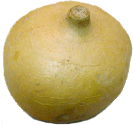|
Elaine M. D'Sa, Ph.D. |
 |
What is Jicama?
Jicama (Pachyrhizus erosus or Pachyrhizus tuberosus) — also called yam bean, Mexican turnip, and Mexican/Chinese potato — is a fleshy, light-brown colored root vegetable that resembles a large turnip, and is native to Latin America. It has a crisp texture (somewhat between that of a raw white potato and a Chinese water chestnut), and a bland flavor that makes it suited to a variety of dishes. It sometimes grows to large sizes over 5 pounds, but smaller tubers are usually preferred for most dishes. Jicama is naturally low-calorie (25 calories per 60-gram or ½-cup serving, raw), fat-free, very low sodium, and an excellent source of Vitamin C; one serving of raw jicama supplies 20% of the Daily Value for Vitamin C. There are also approximately 3 grams of fiber per serving.
Selection and Storage
Some jicama are grown in Texas, but most of those available in grocery stores are imported from Mexico and South America and available year-round. Choose firm, fresh, thin-skinned tubers that are free from cracks, bruises, blemishes, mold or discoloration. Those weighing under 4 pounds are better quality; larger jicama may be very fibrous and starchy, and not as crisp or sweet as smaller sized tubers.
The ideal storage temperature is 55 to 59°F (12.5 to 15°C); at this temperature fresh jicama should keep for up to 4 months. However, some jicama purchased in stores may only last 1 to 2 weeks if inappropriately handled during distribution. If stored at lower temperatures, chilling injury causing decay, discoloration or loss of texture may occur. It is essential that the tubers remain dry; store unwrapped at cool room temperatures, or in the refrigerator, free from moisture, for 2 to 3 weeks. Once cut, cover tightly with plastic wrap, and store refrigerated for up to one week. Each pound of jicama yields about 3 cups chopped or shredded vegetable.
Using Fresh Jicama
Wash jicama well, removing any stringy roots, and peel off the outer brown skin. Remove any fibrous layer underneath. Use shredded, sliced, cubed, cut into sticks or rounds. An advantage of using jicama is that when cut up and exposed to air, it does not discolor or soften for some time. It is mainly used as a starch source, either eaten raw or cooked in a variety of ways. For something more exotic than usual, use as crudités with dips; in stir-fries; cut up to eat raw, in salads; or marinated in lime juice and topped with chili powder. Jicama usually stays crisp when cooked gently — sautéed or stir-fried. It can also be cooked like potatoes — boiled, baked or mashed.
Jicama in Home Food Preservation
The crisp texture and natural-color retention properties of jicama make it valuable in various home-canned products. Through the preservation process you are altering the nutritional value of raw jicama in your meals, but these condiments make nice alternatives and side dishes to jazz up your plate and palate! They are easy to prepare — novel items that add variety to any meal.
Bread and Butter Pickled Jicama — a crisp mix for those who like the flavor of a traditional bread and butter pickle. This one features cubes of jicama, sweet bell pepper, sliced onion, vinegar and spices.
| Chayote and Jicama Slaw — a pickled product combining julienned strips of two exotic vegetables. Use as a topping for hot dogs or a side to grilled pork loin. |  |
 |
Spicy Jicama Relish — a spicy salsa-style pickled relish recipe. Diced jicama, sweet peppers, fingerhots, hot pepper flakes and pickling spices make up this unique salsa. Use on the side to add that crisp note to the menu. |
References and additional information can be found at:
- Centers for Disease Control and Prevention 5 A Day website: http://www.cdc.gov/nccdphp/dnpa/5aday/month/tubers.htm
- Schneider, Elizabeth. 1986. Jicama. In Uncommon Fruits and Vegetables — A Commonsense Guide. Harper and Row Publishers, New York, NY.
Elaine M. D'Sa is Research Coordinator with the National Center for Home Food Preservation, Department of Foods and Nutrition, College of Family and Consumer Sciences, The University of Georgia, Athens.
Images are courtesy of the National Center for Home Food Preservation, The University of Georgia, Athens, GA.
This material is based upon work supported by the Cooperative State Research, Education, and Extension Service, U.S. Department of Agriculture, under Agreement No. 00-51110-9762.
Document Use:
Permission is granted to reproduce these materials in whole or in part for educational purposes only (not for profit beyond the cost of reproduction) provided the authors and the University of Georgia receive acknowledgment and this notice is included:
Reprinted with permission of the University of Georgia. E. D'Sa. 2004. Using and Preserving Jicama. Athens, GA: The University of Georgia, Cooperative Extension Service.
References to commercials products, services, and information is made with the understanding that no discrimination is intended and no endorsement by the University of Georgia, U.S. Department of Agriculture and supporting organizations is implied. This information is provided for the educational information and convenience of the reader.